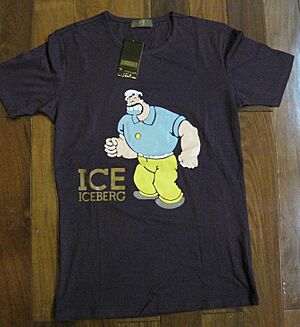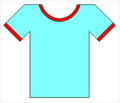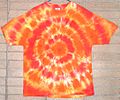T-shirt facts for kids
A T-shirt or tee shirt is a popular type of shirt that has sleeves which are usually short. These sleeves cover your shoulders and the top part of your arm, but they don't go down to your elbow or forearm. T-shirts are often made from soft cotton fabric or a mix of cotton and polyester. People usually wear T-shirts for casual activities, like playing sports or just hanging out. Both boys and girls, and men and women, wear T-shirts in many countries around the world, like the United States, Canada, England, and France.
Contents
What is a T-shirt?
A T-shirt gets its name because its shape looks like the letter "T" when it's laid flat. It's a simple, comfortable top that you pull over your head. T-shirts don't have collars or buttons, which makes them easy to wear. They are a very common piece of clothing for everyday use.
Materials Used in T-shirts
Most T-shirts are made from cotton. Cotton is a natural fiber that feels soft and lets your skin breathe, which is why it's so comfortable. Sometimes, T-shirts are made from a mix of cotton and polyester. Polyester is a man-made fiber that helps the T-shirt dry faster and resist wrinkles. You might also find T-shirts made from other materials like rayon or spandex, which can make them stretchy or extra soft.
Different Styles of T-shirts
Even though T-shirts are simple, they come in many different styles!
- Crew neck: This is the most common style, with a round neckline that fits close to your neck.
- V-neck: These T-shirts have a neckline shaped like the letter "V".
- Scoop neck: Similar to a crew neck, but the neckline is wider and lower.
- Ringer T-shirt: This style has a different colored band around the collar and sleeves.
- Graphic T-shirt: Many T-shirts have pictures, words, or designs printed on them. These are called graphic T-shirts.
- Tie-dye T-shirt: These T-shirts are dyed in a special way to create colorful, swirly patterns.
History of the T-shirt
The T-shirt we know today actually started as an undershirt. In the late 1800s, workers would cut their union suits (a one-piece underwear garment) in half to stay cooler in hot weather. This created a separate top and bottom.
T-shirts in the Military
During the First World War, American soldiers noticed European soldiers wearing lightweight cotton undershirts. When they returned home, these comfortable shirts became popular. The United States Navy officially adopted the T-shirt as part of its uniform in 1913. Sailors wore them under their uniforms, but also as a comfortable work shirt in hot conditions.
T-shirts Become Popular Clothing
After World War II, T-shirts became even more common. They were seen as casual and comfortable clothing. In the 1950s, famous actors started wearing T-shirts in movies, which made them very fashionable. Soon, T-shirts were not just underwear; they were a cool and popular item of clothing for everyone.
How T-shirts are Made
Making a T-shirt involves several steps:
- Growing the cotton: Cotton plants are grown, and their fluffy fibers are harvested.
- Spinning the yarn: The cotton fibers are spun into long threads called yarn.
- Knitting the fabric: The yarn is then knitted into large sheets of fabric. This is why T-shirts are stretchy and soft.
- Cutting the pieces: Patterns for the front, back, and sleeves of the T-shirt are cut from the fabric.
- Sewing the T-shirt: All the pieces are sewn together to create the finished T-shirt.
- Adding designs: If a T-shirt has a graphic or print, it's added at this stage using methods like screen printing or digital printing.
Caring for Your T-shirts
To keep your T-shirts looking good, it's best to wash them in cold water and dry them on a low heat setting or hang them to dry. This helps prevent them from shrinking or fading, especially if they have printed designs.
Images for kids
-
An example of a tie-dyed T-shirt
See also







